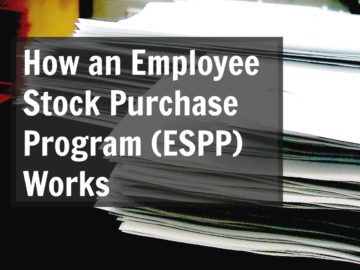 One of the biggest perks of working for a publicly traded company is an Employee Stock Purchase Program (ESPP).
One of the biggest perks of working for a publicly traded company is an Employee Stock Purchase Program (ESPP).
Employee Stock Purchase Program’s allow employees to contribute a certain percentage of each paycheck towards the purchase of company stock.
At pre-determined intervals – such as every six months – the balance is used to purchase company stock at a discount.
ESPPs can provide thousands of extra dollars to an employee’s overall pay, especially if the company has a lookback provision, which I’ll describe shortly.
Today I’ll explain how Employee Stock Purchase Programs work, as well as what tax rules apply.
My Company’s Employee Stock Purchase Program (ESPP)
My company’s ESPP is a good one. In fact, it almost acts like a small “guaranteed” bonus every six months. Allow me to explain.
The year is split into two six-month purchase periods. Before a purchase period starts, you have to elect what percentage of your paycheck will go towards the ESPP. You can dedicate 0-10% with 0 being the default.
Over the course of the six-month purchase period, the percentage you elected is taken out of your paycheck (after taxes) and put into a separate account. Once the purchase period is over, that amount will be used to purchase company stock. You can sell immediately if you want, or hang on to it as long as you want.
The stock is purchased at the lower of two prices, at a 15% discount. The first price is the stock price on the first day of the purchase price and the second price is the last day of the purchase period.
To understand how this works, let’s review two different scenarios:
- Stock price on last day of purchase period is lower than the first day of the purchase period
In this case the stock price went down over the six month period. No worries, though, you still get the stock at a 15% discount. If the stock went from $100 to $50, the stock would be purchased at $42.50 ($50 * 85%). If you sell immediately you lock in your 15% discount.
- Stock price on last day of purchase period is higher than the first day of the purchase period
In this case the stock price went up over the six month period. If the stock went from $25 to $50, the stock would be purchased at $21.25 ($25 * 85%). If you sell immediately you lock in your 235% gain.
As you can see, with a benefit like this you’d have to be ignorant or dumb to not take full advantage of it. Okay, dumb is a strong word – I won’t pretend to know everyone’s situation. But I will say the $25 to $50 change in stock price actually happened once while I was at the company and it was a great “mini bonus.”
The ESPP plan I described is one of the most favorable allowed by law. Not every company will have as favorable of terms.
Some companies may only offer a 5% discount or may require a longer holding period before you can sell company stock purchased through the ESPP. Another large corporation in the metro area where I live forces you to wait either two or three years before you can sell your company stock. Other companies will have no “lookback provision,” where the stock is purchased at the lower of two prices. Instead they will just take into consideration the price at the end of the purchase period.
When to Cash Out & Tax Considerations
I think we’ve already established that you should absolutely participate in the ESPP if your company offers one. With that established there is a new question that you should be seeking an answer to: when should I cash out my ESPP?
A strong argument can be made for cashing out ESPP stock as soon as possible. The logic being:
- Lock in gains – If company stock is purchased at a discount, those gains can be locked in immediately if the stock is sold as soon as possible.
- Avoid overexposure to company – An employee is already over-exposed to their employer due to the fact they are an employee of the company. The last thing an employee needs is even further exposure to a company. I shouldn’t even have to say this, but…Enron?
Selling ESPP company stock seems like a good idea, but there are tax implications to consider. According to TurboTax:
If you hold the stock for less than a year before you sell it, any gains will be considered compensation and taxed as such. If you hold the shares for more than one year, any profit will be taxed at the usually lower capital gains rate.
There are a few different scenarios that could arise, but let’s keep it simple: if you sell immediately, you will pay short-term capital gains on the profit instead of long-term capital gains. To view other potential scenarios that would result in different tax rates (i.e. long-term capital gains), I would highly suggest reading some of the examples at TurboTax.
Whether or not to sell or hold onto the stock is up to you, but there are pros and cons to each approach. If you don’t need the cash immediately but also would like to make sure you don’t lose your gains, you could put in a stop-loss order that sells the stock if it falls below a certain predetermined price. For example, if the current price of the stock is $50 I may set a stop-loss order for $48. If the stock never goes down to that level, I will continue to hold the stock. If it starts losing value and hits the trigger price of $48, the stock will sell.
The bottom line is this: employee stock purchase program’s (ESPP) works in the favor of the employee. The value of this benefit should be recognized by employees and taken advantage of by employees. Opting out of an ESPP typically means leaving part of your compensation on the table.
____________
Have you participated in an employee stock purchase program (ESPP) before? Do you factor in an ESPP (or lack of an ESPP) when looking for jobs?
____________
Photo by Joel Penner


Yours is structured so differently from mine! That lowest cost point is amazing. With mine, we purchase stocks on payday (twice per month) and it takes one year from date of purchase for them to vest. We can put in up to 6% of our salary and for every three units we purchase, the company purchases one. You can sell them before the one year vest period, however you lose the company contribution.
I used to participate in this with my former employer until Enron went bankrupt and I saw how dangerous it was to invest in your company, especially since you are fully invested through your salary. If the plan is compelling, though, and you balance how much you invest, I think it could make sense.
Good breakdown DC. I helped people with their ESPP’s quite a bit in my former job. There can be quite a few differences with them, but think it’s wise to take advantage of it as is reasonable for you of course – especially if it’s a good plan. Strangely enough, my company did not offer an ESPP but we could purchase stock directly through our 401(k) though.
moneypropeller I got very lucky ending up at a company that has a great ESPP…literally just got stock a week or so ago for a 49% discount/gain. It’s hard to believe! But your program seems like it would definitely pay off to participate in. Getting one out of every four provided by the company would be really great. Like getting a 25% discount.
FrugalRules That’s interesting that you didn’t have an ESPP. Now that I’m used to getting a “bonus” through the ESPP every six months I would want a higher salary to compensate if I ever went to another company that didn’t have an ESPP program.
blonde_finance With the plan I described – the one I have at my work – you can sell as soon as you receive your stocks. You are essentially “guaranteed” a 15% bonus, and there is no risk if you sell right away. I always tell people to give the 10% max and they can always sell right away if they want.
I’ve never had the option, but I think it would depend on the rules as to whether I’d jump in or not. It sounds like you have a sweet deal, but, like Shannon, I remember people getting screwed over by certain companies. With any investment, you have to look at all the pros and cons.
Great breakdown! A lot of people don’t know the details of this option. It doesn’t apply to me right now, but I’m going to remember it as a resource if I hear anyone talking about it and needs more info!
Eyesonthedollar I actually would be really interested in seeing the details behind the Enron ESPP. The biggest question I would have is: did the employees have the ability to sell the stock? Also, I’m curious what % of employee’s assets was actually in stock versus their 401k. If the employees had the ability to sell their stock and held an enormous % of their income in Enron, it’s hard to say it was entirely Enron’s fault.
Financegirl Thanks! One thing that really disheartens me is when I talk to people at my own company about the plan and they don’t participate. It truly is a 15% bonus every six months (if not much more!).
Here’s what I’m going to do – go see if we have this option at work (I’ll feel dumb if we do), then come back and read this again in more detail.
Mark@BareBudgetGuy Hmmm I’d be really surprised if your company has the option, considering the fact you aren’t sure. Our company promotes it pretty well (as they should). It has potential to be a pretty big bonus if the stock performs well (and can be sizable even if it doesn’t perform well).
Share/Stock purchase plans are an amazing way to start investing, without trying very hard, mainly because it requires little to no discipline.
I work for a company that has a very small plan capability, but I make sure I make the most of it every year!
The only major downside of ESPPs is that if you’re a novice investor, it might be your only holding in a portfolio, creating some SERIOUS concentration risk in your portfolio.
You also need to be REALLY careful to understand how they are taxed.
That is fascinating. You’re absolutely right. Not taking advantage of a program like this is definitely not a brilliant move.